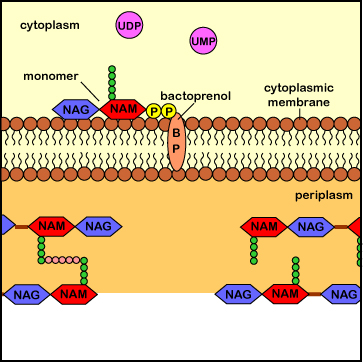
Peptidoglycan monomers are synthesized in the cytosol of the bacterium where they attach to a membrane carrier molecule called bactoprenol. The bactoprenols transport the peptidoglycan monomers across the cytoplasmic membrane and helps insert them into the growing peptidoglycan chains.
a. First, N-acetylglucosamine (NAG) links up with uridine diphosphate (UDP) to form UDP-NAG. Some of the NAG is enzymatically converted to N-acetylmuramic acid (NAM) forming UDP-NAM.
b. Five amino acids are sequentially added to the UDP- NAM forming a pentapeptide. The last two are D-alanine molecules enzymatically produced from L-alanine, the usual form of the amino acid.
c. The NAM-pentapeptide is attached to the bactoprenol carrier molecule in the cytoplasmic membrane, the energy being supplied by one of the high-energy phosphate groups of the UDP.
d. The NAG is attached to the NAM-pentapeptide on the bactoprenol to complete the peptidoglycan monomer.
Bactoprenols then insert the peptidoglycan monomers into the breaks in the peptidoglycan at the growing point of the cell wall.
Illustration of the Synthesis of Peptidoglycan Monomers and Action of Bactoprenol,
Step 2 .jpg by Gary E. Kaiser, Ph.D.
Professor of Microbiology,
The Community College of Baltimore County, Catonsville Campus
This work is licensed under a Creative Commons Attribution 4.0 International License.
Based on a work at https://cwoer.ccbcmd.edu/science/microbiology/index_gos.html.
Last updated: Feb., 2021
Please send comments and inquiries to Dr.
Gary Kaiser